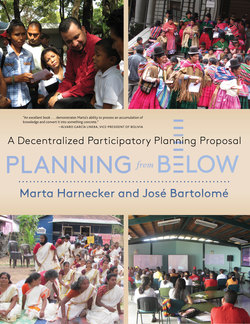Читать книгу Planning from Below - Marta Harnecker - Страница 6
На сайте Литреса книга снята с продажи.
ОглавлениеFOREWORD
Democratic decentralisation and popular participation in the development process were important elements of the agenda of the first communist government elected after the formation of the new state of Kerala, India in 1957. However, comprehensive legislation for empowering local governments was abandoned after the communist government was dismissed by the Centre Cabinet following violent anti communist agitations by right wing forces. Kerala had to wait four decades until the victory of the Left Democratic Front (LDF} in the 1996 state elections for this dream to become a reality.
By then the national parliament had amended the Indian Constitution making the local governments as a mandatory and uniform third tier of governance below the Central and the State governments. The Left in Kerala utilised this opportunity for large scale mass mobilisation for initiating decentralised planning and to empower the local government structure. More than a third of the state plan budget for new projects and schemes were devolved to the local governments. But they had to prepare comprehensive local plans before they could claim the allotted funds. Procedures were laid down to ensure that the process to develop these plans was inclusive, participatory and scientific. Thus, a hitherto technical planning process was turned into a tool for social mobilisation at several levels, all the way to the grassroots. This movement was called Peoples Plan Campaign (PPC).
As the then Kerala Planning Board Member in charge of the PPC, I was totally engrossed in this process. But at that point I had not yet read about the international experiences of
participatory planning. The PPC was a home grown project and the experience that we were relying on was our own. Firstly, the numerous micro development experiments that were blossoming in the region, particularly initiated by Peoples Science Movement. The second source of inspiration was the studies of the academics and researchers in institutions such as Centre for Development Studies (CDS) in Kerala. Finally, the political debates within the Communist Movement, and the aggressive stand of veteran communist leaders like EMS Namboodiripad in favour of decentralisation, provided the political vision. It was therefore a surprise for me to know that similar experiments were successfully carried out in Latin America, and that it was in fact an important component of Left political parties inthe reg10n.
Later, there were opportunities to exchange ideas about the experiences elsewhere. For instance, I heard of the experiments in Porto Alegre through my participation at a conference in Wisconsin, USA. Subsequently my book on participatory planning experiences of Kerala was translated and published in Spanish and Portuguese. I had known of Marta as an advisor to the Government of Hug·o Chavez in Venezuela and had a great interest in meeting her. I had an invitation to attend the Conference of Intellectuals, Artists and Social Movements in Defence of Humanity held in Venezuela in 2004, but was unable to travel there. Finally, I met Marta when she travelled to India in March 2014, which is also when I came to know about her books and videos on participatory planning.
During that visit, she travelled across Kerala to understand the process that had taken place here. She interacted with local government representatives, academics, visited cooperatives and we had long discussions and debates on the vision for 21st century socialism. Marta has this student-like curiosity to understand intimately how things were done so that beyond the broad framework, she is able to relate with the experience of a process she seeks to understand. But what struck me most was that she was not working on a theoretical monograph, but on a more practical manual on how best to democratise political processes on the ground.
For socialism to succeed, in the future, it will need a high level of popular participation. It is fulfilling that from mere objects, people can become active agents of their political and social life. There is a lesson in the fact that where the Left is strong, this democratisation agenda is present; this democratisation does not have to wait for socialism to be a reality, rather it can be a powerful instrument in the struggle for socialism. We know how to utilise parliamentary democracy and constitutional rights to mobilise and organise people.pre
Participatory planning deepens the democratic content of our struggles and therefore has the potential to strengthen mobilisation for progressive transformation.
Thus the design of the decentralisation process is very important, along with adequate tools that can be readily understood and used. Building on systematic learning from experiences in different countries, this book offers exactly that.
Such a process of progressive transformation is in constant need to reinvent itself to avoid routinisation and bureaucratic capture and to ensure that one is addressing a ground situation that is always in flux. I cannot emphasise enough, the relevance to have such a perceptive scrutiny of the Kerala experience, as well as provide a comparative analysis of similar experiences.
Finally, it is commendable that despite being faced with immense challenges on the health front, Marta remains consistently involved in our common and collective struggle for progressive transformation towards socialism.
This book is a testimony to her resolve for a just and better world.
—DR. T. M. THOMAS ISSAC
Finance Minister of Kerala State, India
March 2018
